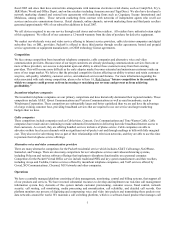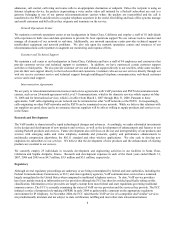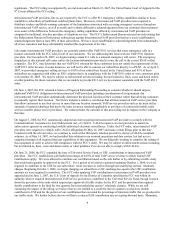8x8 2007 Annual Report Download - page 18
Download and view the complete annual report
Please find page 18 of the 2007 8x8 annual report below. You can navigate through the pages in the report by either clicking on the pages listed below, or by using the keyword search tool below to find specific information within the annual report.provided in a particular purchase order. The inability of these third party vendors to deliver components of acceptable quality
and in a timely manner, particularly the sole source vendors, could adversely affect our operating results or cause them to
fluctuate more than anticipated. Additionally, some of our products may require specialized or high-performance component
parts that may not be available in quantities or in time frames that meet our requirements.
We may have difficulty identifying the source of the problem when there is a problem in a network.
Our Packet8 service must successfully integrate with products from other vendors, such as gateways to traditional telephone
systems. As a result, when problems occur in a network, it may be difficult to identify the source of the problem. The
occurrence of hardware and software errors, whether caused by our Packet8 service or another vendor's products, may result in
the delay or loss of market acceptance of our products and any necessary revisions may force us to incur significant expenses.
The occurrence of some of these types of problems may seriously harm our business, financial condition or results of
operations.
Our infringement of a third party’s proprietary technology would disrupt our business.
There has been substantial litigation in the communications, VoIP services, semiconductor, electronics, and related industries
regarding intellectual property rights, and from time to time third parties may claim infringement by us of their intellectual
property rights. Our broad range of technology, including IP telephony systems, digital and analog circuits, software, and
semiconductors, increases the likelihood that third parties may claim infringement by us of their intellectual property rights. If
we were found to be infringing on the intellectual property rights of any third party, we could be subject to liabilities for such
infringement, which could be material. We could also be required to refrain from using, manufacturing or selling certain
products or using certain processes, either of which could have a material adverse effect on our business and operating results.
From time to time, we have received, and may continue to receive in the future, notices of claims of infringement,
misappropriation or misuse of other parties' proprietary rights. There can be no assurance that we will prevail in these
discussions and actions or that other actions alleging infringement by us of third party patents will not be asserted or prosecuted
against us.
Certain technology necessary for us to provide our services may in fact be patented by other parties either now or in the future.
If such technology were held under patent by another person, we would have to negotiate a license for the use of that certain
technology. We may not be able to negotiate such a license at a price that is acceptable. The existence of such a patent, or our
inability to negotiate a license for any such technology on acceptable terms, could force us to cease using such technology and
offering products and services incorporating such technology.
We rely upon certain technology, including hardware and software, licensed from third parties. There can be no assurance that
the technology licensed by us will continue to provide competitive features and functionality or that licenses for technology
currently utilized by us or other technology which we may seek to license in the future will be available to us on commercially
reasonable terms or at all. The loss of, or inability to maintain, existing licenses could result in shipment delays or reductions
until equivalent technology or suitable alternative products could be developed, identified, licensed and integrated, and could
harm our business. These licenses are on standard commercial terms made generally available by the companies providing the
licenses. The cost and terms of these licenses individually are not material to our business.
Inability to protect our proprietary technology would disrupt our business.
We rely in part on trademark, copyright, and trade secret law to protect our intellectual property in the United States and
abroad. We seek to protect our software, documentation, and other written materials under trade secret and copyright law,
which afford only limited protection. We also rely in part on patent law to protect our intellectual property in the United States
and internationally. As of May 30, 2007, we hold 68 United States patents and have additional United States and foreign patent
applications pending. We cannot predict whether such pending patent applications will result in issued patents that effectively
protect our intellectual property. We may not be able to protect our proprietary rights in the United States or internationally
(where effective intellectual property protection may be unavailable or limited), and competitors may independently develop
technologies that are similar or superior to our technology, duplicate our technology or design around any patent of ours. We
have in the past licensed and in the future expect to continue licensing our technology to others many of whom are located or
may be located abroad. There are no assurances that such licensees will protect our technology from misappropriation.
Moreover, litigation may be necessary in the future to enforce our intellectual property rights, to determine the validity and
scope of the proprietary rights of others, or to defend against claims of infringement or invalidity. Such litigation could result in
substantial costs and diversion of management time and resources and could have a material adverse effect on our business,
financial condition, and operating results. Any settlement or adverse determination in such litigation would also subject us to
significant liability.
16
























